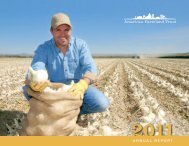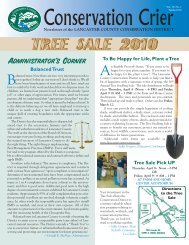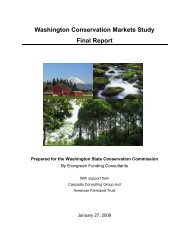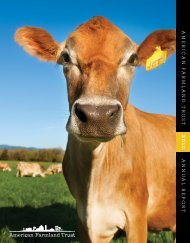2009 Annual Report - American Farmland Trust
2009 Annual Report - American Farmland Trust
2009 Annual Report - American Farmland Trust
You also want an ePaper? Increase the reach of your titles
YUMPU automatically turns print PDFs into web optimized ePapers that Google loves.
A n n u a l R e p o r t 2 0 0 9
Saving the Land<br />
that Sustains Us<br />
<strong>American</strong> <strong>Farmland</strong> <strong>Trust</strong> (AFT) is the first and only national nonprofit<br />
membership organization dedicated to helping America’s farmers<br />
and ranchers protect their land, produce a healthier environment<br />
and build successful communities. Founded in 1980 by a group of<br />
farmers and conservationists concerned about the rapid loss of<br />
farmland to development, <strong>American</strong> <strong>Farmland</strong> <strong>Trust</strong> is the nation’s<br />
leading advocate for healthy farms, healthy food and a healthy<br />
environment. Our work has helped to save more than three million<br />
acres of farm and ranch land from development and led the way for<br />
establishing sound environmental practices on millions more.<br />
On the cover: Harvest Study, a recent work by painter Harry Orlyk,<br />
who has been documenting <strong>American</strong> farmland for over thirty years.<br />
Orlyk works on site, year round, in the fields and back roads of<br />
Washington County, New York.<br />
“Each evening, workers leave the potato harvest near the village of<br />
Salem, New York, giving themselves and their machines the night to<br />
rest,” says Orlyk. “This year I painted the resting machines where they<br />
were left, in the light just before darkness. Harvest Study is one of 25<br />
made this September and October, <strong>2009</strong>.”<br />
For more information, visit www.harryorlyk.com.<br />
ii
Contents<br />
1 From the Leadership<br />
2 Agriculture &<br />
Environment<br />
6 Growing Local<br />
10 <strong>Farmland</strong> Protection<br />
14 Supporters<br />
27 Financial Summary<br />
29 Board of Directors<br />
and President’s<br />
Council<br />
From the Leadership<br />
“I_ know of no pursuit in which more real<br />
and important services can be rendered<br />
to any country than by improving its<br />
agriculture….” This quote was spoken by our<br />
country’s “founding farmer” George Washington,<br />
a passionate advocate of the land who recognized<br />
the fundamental role farmers play in feeding the<br />
nation and protecting our natural resources.<br />
Much has changed since George Washington’s<br />
time, but the truth of his words remains.<br />
Farmers are responsible for growing and raising<br />
the healthy food we need to sustain our own<br />
citizens and the world. They steward nearly half<br />
the nation’s land, giving shelter to wildlife and<br />
watching over rivers, streams, forests and the soil.<br />
And current challenges demand even more from<br />
farmers—as the need for clean water, renewable<br />
energy and greenhouse gas reductions call for<br />
farmers to play an even greater role in the nation’s<br />
well-being.<br />
Since our start, this knowledge has formed<br />
the core of <strong>American</strong> <strong>Farmland</strong> <strong>Trust</strong>’s work. For<br />
three decades, we have been the leading national<br />
organization<br />
working<br />
to protect<br />
farmland<br />
and farms—<br />
Jon Scholl John Winthrop, Jr.<br />
because we<br />
know how much the nation depends on them. From<br />
launching farmland protection programs across the<br />
country to pioneering conservation practices that<br />
keep the land healthy, <strong>American</strong> <strong>Farmland</strong> <strong>Trust</strong><br />
has been at the forefront of efforts to make sure we<br />
have fresh food, a healthy environment, protected<br />
farmland and strong local economies.<br />
For 30 years, supporters like you have helped<br />
us make a difference. With your support, we will<br />
continue making a difference for the next 30. You<br />
can help us realize our vision of a nation where<br />
healthy and protected farms and ranches provide<br />
critical environmental and “green” services while<br />
producing fiber and food for the nation and world.<br />
jon scholl<br />
President<br />
john winthrop, jr.<br />
Chair<br />
1
Agriculture & Environment<br />
With 30 years of experience working at the<br />
crossroads between agriculture and the<br />
environment, <strong>American</strong> <strong>Farmland</strong> <strong>Trust</strong><br />
is a national leader in promoting farm policies that<br />
protect the environment while being practical for<br />
the nation’s farmers. From reducing pesticide use<br />
to expanding conservation benefits in the federal<br />
farm bill, our work in the field helps farmers adopt<br />
environmentally friendly practices, while our<br />
advocacy keeps conservation front-and-center in<br />
the nation’s farm policies.<br />
As a result, the nation’s farmers and ranchers<br />
are better stewards of the land than ever before.<br />
But many challenges remain. The runoff of topsoil,<br />
nutrients and chemicals from agricultural lands<br />
is still a major source of pollution. And climate<br />
change poses both a great threat and a significant<br />
opportunity for agriculture, with the potential for<br />
farmers and ranchers to play a key role in efforts to<br />
reduce the nation’s greenhouse gas emissions.<br />
www.farmland.org/environment<br />
A healthy environment depends upon farmers<br />
and ranchers, who manage nearly half the nation’s<br />
land. Studies have shown that environmentally<br />
friendly agricultural practices are among the most<br />
cost-effective solutions to both water quality and<br />
climate change. That’s why <strong>American</strong> <strong>Farmland</strong><br />
<strong>Trust</strong>’s Agriculture & Environment initiative—backed<br />
by solid research and our unique ability to bring<br />
divergent interests together—is so important.<br />
From the fragile ecosystems of the Pacific<br />
Northwest to the impaired waterways of the<br />
Ohio River Basin and the Chesapeake Bay, the<br />
Agriculture & Environment initiative is forging new<br />
paths for farmers and ranchers as they improve<br />
the environment and participate in an emerging<br />
green economy. Whether piloting “ecosystem<br />
markets” that pay farmers and ranchers for<br />
their conservation efforts, or engaging farmers<br />
and ranchers in the debate over climate change<br />
legislation, we are working toward a cleaner<br />
environment and a stronger agricultural industry—<br />
critical work that is vital to us all.<br />
2
The Susquehanna<br />
River flows past fertile<br />
farmland in Danville,<br />
“Farms and ranches offer many<br />
effective solutions to the most pressing<br />
environmental challenges we face today,<br />
from climate change to water pollution.”<br />
— Buzz Thompson, Board Chair, AFT’s<br />
Agriculture & Environment initiative<br />
Successes<br />
In <strong>2009</strong>, <strong>American</strong><br />
<strong>Farmland</strong> <strong>Trust</strong>’s<br />
Agriculture & Environment<br />
initiative worked with<br />
farmers and ranchers<br />
to address major<br />
national environmental<br />
challenges, including<br />
water quality and climate<br />
change. Our efforts:<br />
Built support among<br />
agriculture leaders<br />
and policy makers for<br />
a national carbon capand-trade<br />
program. We<br />
successfully organized<br />
a collaborative working<br />
relationship among<br />
a group of five major<br />
agriculture organizations<br />
seeking opportunities<br />
for farmers and ranchers<br />
to play a positive role in<br />
reducing greenhouse gas<br />
emissions. The influential<br />
alliance represented the<br />
most significant counterweight<br />
to the many<br />
agriculture organizations<br />
working against strong<br />
climate change policies.<br />
Prepared farmers for<br />
the future of renewable<br />
energy and carbon<br />
trading. In advance<br />
of potential climate<br />
change legislation,<br />
<strong>American</strong> <strong>Farmland</strong><br />
<strong>Trust</strong> held “Agriculture<br />
and Clean Energy”<br />
workshops and webinars<br />
across the country<br />
to educate farmers<br />
and rural <strong>American</strong>s<br />
about opportunities<br />
in renewable energy<br />
and greenhouse gas<br />
mitigation. >><br />
Pennsylvania.<br />
3
A sunset viewed from rolling hills of orchards<br />
in the Hood River Valley, Oregon<br />
4
Achieved the<br />
conservation promise of<br />
the 2008 Farm Bill.<br />
Our legislative advocacy<br />
helped secure nearly all<br />
the conservation funding<br />
promised by the bill—a<br />
significant victory for the<br />
conservation community.<br />
Allowed farmers to<br />
increase their adoption of<br />
conservation practices.<br />
Our BMP Challenge<br />
program demonstrated<br />
that farmers can reduce<br />
fertilizer use and adopt<br />
conservation practices<br />
while maintaining or<br />
improving profits. We<br />
expanded the program to<br />
California and Maryland,<br />
while increasing the<br />
acreage enrolled in<br />
Pennsylvania and other<br />
states. In Pennsylvania,<br />
farmers in the program<br />
generated nitrogen<br />
credits approved by the<br />
state’s water quality<br />
trading board—a potential<br />
new revenue source for<br />
participating farmers.<br />
Laid the groundwork<br />
for water credit trading<br />
systems that improve<br />
water quality and<br />
strengthen agriculture.<br />
We continued our<br />
efforts with partners to<br />
develop the country’s<br />
first regional water<br />
quality trading system in<br />
the 14-state Ohio River<br />
Basin—a model for how<br />
farmers and factories<br />
can work together to<br />
reduce pollution. In the<br />
Sauk River watershed<br />
of Minnesota, we<br />
worked with partners<br />
to finalize protocols for<br />
a trading market that<br />
will begin accepting<br />
trades in 2010. And in<br />
the Chesapeake Bay, we<br />
convened agriculture<br />
leaders to advance<br />
goals for the restoration<br />
effort, which will work<br />
region-wide to help<br />
farmers reduce pollution<br />
that impairs the bay.<br />
Helped farmers<br />
grow more sustainably.<br />
Our research staff<br />
and California office<br />
developed performance<br />
metrics for fruit,<br />
vegetable and nut<br />
growers, giving them<br />
a practical yardstick<br />
for measuring the<br />
environmental effects<br />
of their management<br />
decisions. And grants<br />
awarded through<br />
our integrated pest<br />
management (IPM)<br />
program helped growers<br />
around the country<br />
reduce and eliminate<br />
highly toxic pesticides.<br />
Continued to pioneer<br />
the development of<br />
innovative conservation<br />
markets. In the Pacific<br />
Northwest, <strong>American</strong><br />
<strong>Farmland</strong> <strong>Trust</strong> launched<br />
a special effort to identify<br />
ways that ecosystem or<br />
conservation markets—<br />
which compensate farm<br />
and forest landowners<br />
for providing important<br />
environmental services,<br />
from wildlife habitat<br />
to flood control—can<br />
be used to protect<br />
agricultural lands. We<br />
educated farmers and<br />
agriculture groups about<br />
the opportunities of<br />
environmental markets;<br />
as a result of our work, the<br />
Washington Farm Bureau<br />
made creating ecosystem<br />
markets one of its top<br />
legislative priorities<br />
for the first time.<br />
5
Growing Local<br />
For three decades, <strong>American</strong> <strong>Farmland</strong> <strong>Trust</strong><br />
has worked to create a thriving future<br />
for our nation’s farms. We’ve developed<br />
forward-looking plans for agriculture, smart growth<br />
and rural development in communities around<br />
the nation. We’ve helped a multitude of states and<br />
communities create and improve programs that<br />
protect farmland from sprawling development.<br />
And we’ve pioneered economic and land studies to<br />
tell the full story of the cost of farmland loss and<br />
highlight the importance of urban-edge agriculture.<br />
Now we’re taking our 30 years of work to the<br />
logical next step. With our Growing Local initiative,<br />
we’re fostering connections between the farmers<br />
and farm fields that grow our local food and the<br />
communities and consumers that increasingly<br />
depend on them. This is especially critical work<br />
today because the urban-edge farms that grow<br />
the majority of the nation’s fruits, vegetables and<br />
dairy products are highly threatened by sprawling<br />
www.farmland.org/growinglocal<br />
development, difficult market conditions and a host<br />
of other challenges.<br />
From the nation’s “salad bowl” in California’s<br />
fertile Central Valley to the rapidly suburbanizing<br />
communities of New Jersey’s Burlington County,<br />
our Growing Local initiative is working to sustain<br />
local farms while strengthening the nation’s food<br />
and farming system. We are helping communities<br />
meet the demand for local food by planning for<br />
local food systems, farmland protection and smart<br />
growth. We are boosting the small-scale, direct<br />
market farms and farmers markets that provide<br />
locally grown food for communities around the<br />
country. And we are working to open a new door of<br />
opportunity for production agriculture to diversify<br />
and participate in local, sustainable food systems.<br />
As consumers and communities increasingly<br />
demand the health, taste and environmental<br />
benefits of local food, <strong>American</strong> <strong>Farmland</strong> <strong>Trust</strong>’s<br />
Growing Local initiative is more important than<br />
ever. Without local farms, there will be no<br />
local food.<br />
Shoppers at<br />
the Chicago<br />
Farmers Market<br />
in Federal Plaza,<br />
Chicago, Illinois<br />
6
Successes<br />
In <strong>2009</strong>, <strong>American</strong><br />
<strong>Farmland</strong> <strong>Trust</strong>’s Growing<br />
Local initiative helped<br />
farmers and communities<br />
“grow local” by protecting<br />
farmland through smart<br />
growth strategies,<br />
improving the future<br />
for local agriculture and<br />
meeting the increasing<br />
demand for local food.<br />
Our efforts:<br />
Connected consumers<br />
to the farmers who grow<br />
their food. We boosted<br />
support for community<br />
farmers markets,<br />
applauded the work of<br />
market managers and<br />
engaged tens of thousands<br />
of consumers with our<br />
inaugural America’s<br />
Favorite Farmers Markets<br />
contest. And we continued<br />
to recognize the growing<br />
grassroots interest in local<br />
farms and food through<br />
our “No Farms No Food”<br />
campaign, which brought<br />
local consumer support<br />
for farms to the national<br />
level and distributed more<br />
than one million “No<br />
Farms No Food” bumper<br />
stickers, in part through<br />
our partnership with<br />
Stonyfield Yogurt.<br />
Helped urban and<br />
suburban communities<br />
create community food<br />
systems. Burlington<br />
County, New Jersey,<br />
has a nationally<br />
recognized farmland<br />
preservation program<br />
but a local farm and food<br />
system that is struggling<br />
as rapid suburbanization<br />
conflicts with local<br />
agriculture. >><br />
“By supporting local farms we sustain<br />
our local economies. That’s why we<br />
encourage people to ‘eat the view’ and<br />
connect to the harvest and beauty of<br />
our local farmland in every bite.”<br />
— Julia Widdowson, Board Chair,<br />
AFT’s Growing Local initiative<br />
7
Dennis and Sandy<br />
Dierks of Paradise<br />
Valley Produce in<br />
Bolinas, California<br />
<strong>American</strong> <strong>Farmland</strong> <strong>Trust</strong><br />
worked with the county to<br />
turn those conflicts into<br />
opportunities, resulting<br />
in the adoption of a set<br />
of model ordinances<br />
to support local food<br />
production and a new<br />
farmers market to<br />
take advantage of the<br />
suburban light rail line.<br />
Developed policies<br />
and strategies at all<br />
levels of government to<br />
support local farms and<br />
food. In New England, we<br />
worked with governors<br />
and state agricultural<br />
commissioners to<br />
initiate a “Farm and Food<br />
Security Plan” that will<br />
help protect the region’s<br />
agricultural land base and<br />
expand the production<br />
and consumption of<br />
New England-grown<br />
farm and food products.<br />
In California, we<br />
spearheaded the statewide<br />
“California Agriculture<br />
Vision” strategic planning<br />
process, which will<br />
result in a roadmap for<br />
managing growth wisely<br />
and creating robust<br />
regional and local markets<br />
for California-grown<br />
food. In Massachusetts,<br />
we continued efforts<br />
with partners to create a<br />
Massachusetts Food Policy<br />
Council charged with<br />
expanding the production<br />
and consumption of locally<br />
grown food and improving<br />
the economic viability of<br />
agriculture.<br />
Helped communities<br />
address the economic<br />
conditions that threaten<br />
many local farmers. In<br />
North East, New York, the<br />
dairy farm community<br />
found new ways to<br />
keep farms profitable<br />
by expanding into<br />
direct retail markets.<br />
Our New York office<br />
worked with the town to<br />
create strategies to help<br />
local farmers stay in<br />
business.<br />
Planned for the<br />
future of local farms,<br />
food and smart growth.<br />
In New York, we worked<br />
with eight counties and<br />
14 towns to develop<br />
agricultural and farmland<br />
protection plans that help<br />
communities support<br />
local farmers, protect<br />
farmland and strengthen<br />
local food systems. In<br />
Connecticut, our free<br />
Conservation Options for<br />
Connecticut <strong>Farmland</strong><br />
guide advised landowners<br />
and communities on<br />
tools to promote land<br />
protection, smart growth<br />
and farm viability. And in<br />
California, our work on<br />
the San Francisco Urban-<br />
Rural Roundtable—a<br />
committee of city and<br />
agricultural leaders<br />
convened by Mayor<br />
Gavin Newsom—outlined<br />
strategies to increase<br />
local food production<br />
and consumption while<br />
conserving farmland.<br />
9
Farm and Ranch Land Protection<br />
T<br />
hirty years ago, when <strong>American</strong> <strong>Farmland</strong><br />
<strong>Trust</strong> first started, many <strong>American</strong>s were<br />
just waking up to the rapid loss of farm<br />
and ranch land affecting their communities.<br />
Few states or communities had taken steps to<br />
protect agricultural land from the poorly planned<br />
development that was carving up millions of acres<br />
of productive soils into housing lots and shopping<br />
malls.<br />
<strong>American</strong> <strong>Farmland</strong> <strong>Trust</strong>—recognizing the<br />
great threat to the nation’s most precious natural<br />
resource—stepped in and helped guide the way<br />
forward. We pioneered tools and techniques for<br />
protecting working lands, such as conservation<br />
easements that allow farmers and ranchers to<br />
resist the pressure to sell their land to developers.<br />
We educated the public on the critical need to save<br />
farm and ranch land and led the charge at all levels<br />
of government to develop policies and programs<br />
that protect the land and support the farmers who<br />
manage it.<br />
Thanks in part to these efforts, farmland<br />
protection is now a national conservation<br />
movement. Nearly three million acres around the<br />
country have been protected, while more than half<br />
the states in America have programs in place to<br />
protect farm and ranch land. But we can’t stop now.<br />
Around the country, America’s farms and ranches<br />
are still at risk and development pressure still<br />
weighs heavily on the nation’s farmers.<br />
With your support, <strong>American</strong> <strong>Farmland</strong><br />
<strong>Trust</strong> will continue the fight to make sure local<br />
communities and farmers have the tools they need<br />
to protect the land that feeds America and is one of<br />
our most valuable assets in the fight to protect the<br />
environment.<br />
www.farmland.org/protection<br />
10<br />
A housing<br />
development borders<br />
farmland in Suisun<br />
City, California.
“We have to protect farmland<br />
because without it, all the benefits<br />
that farms provide—from a clean<br />
environment to local food—will be lost.”<br />
— Thomas Gallo, Board Chair,<br />
AFT’s <strong>Farmland</strong> Protection initiative<br />
Successes<br />
<strong>American</strong> <strong>Farmland</strong><br />
<strong>Trust</strong> is active on the<br />
federal, state and local<br />
levels—building support<br />
for programs and policies<br />
that protect the nation’s<br />
working lands. In <strong>2009</strong>,<br />
our efforts:<br />
Galvanized support<br />
to strengthen farmland<br />
protection at the national<br />
level. <strong>American</strong> <strong>Farmland</strong><br />
<strong>Trust</strong>-led efforts resulted<br />
in record-breaking<br />
funding for the federal<br />
Farm and Ranch Lands<br />
Protection Program<br />
in the 2010 federal<br />
budget. We also worked<br />
extensively to organize<br />
comments from state and<br />
local partners to help<br />
strengthen the program,<br />
making it work better for<br />
farmers and communities.<br />
11<br />
Secured greater<br />
levels of funding<br />
for state-level farmland<br />
protection programs. In<br />
New York, despite the<br />
bad fiscal environment,<br />
we helped secure<br />
$23 million in state<br />
funding to protect 27<br />
farms and 9,000 acres.<br />
In New England, our<br />
Working Lands Alliance<br />
project secured a<br />
major recommitment<br />
of funding for the<br />
Connecticut <strong>Farmland</strong><br />
Protection Program,<br />
with an agreement to<br />
restore bonding levels<br />
to $10 million per year<br />
through 2011. And in<br />
Massachusetts, Governor<br />
Deval Patrick increased<br />
spending for the state’s<br />
farmland protection<br />
program by more than<br />
$1 million. >>
A Colorado<br />
ranch at<br />
sunrise
Provided cutting-edge<br />
research and technical<br />
advice for farmers, policy<br />
makers and citizens.<br />
Our Texas Land Trends<br />
study, co-released with<br />
Texas A&M University,<br />
and related website shed<br />
light on the rapid pace<br />
of land development<br />
and fragmentation in<br />
Texas. In the Midwest,<br />
we worked with partners<br />
to put on the 4th annual<br />
Illinois <strong>Farmland</strong><br />
Protection Conference<br />
and the 10th Ohio<br />
<strong>Farmland</strong> Preservation<br />
Summit. And our<br />
<strong>Farmland</strong> Information<br />
Center—a partnership<br />
between <strong>American</strong><br />
<strong>Farmland</strong> <strong>Trust</strong> and the<br />
USDA Natural Resources<br />
Conservation Service—<br />
served more than 80,000<br />
people through our<br />
online library of farmland<br />
protection information<br />
and staffed answer<br />
service.<br />
Helped states and<br />
local communities plan<br />
for farmland protection<br />
and smart growth. In<br />
California, we helped<br />
convince regional officials<br />
to adopt a smart growth<br />
“blueprint” plan that<br />
would save 175,000<br />
acres of farmland by<br />
2050; in 2010, we plan<br />
to work to persuade<br />
cities and counties to<br />
carry the blueprint<br />
through. In Guilford<br />
County, North Carolina,<br />
we completed an<br />
Agricultural<br />
Development and<br />
<strong>Farmland</strong> Preservation<br />
Plan that recommends<br />
strategies for linking<br />
farmland protection<br />
with economic<br />
opportunities for<br />
local agriculture.<br />
And we served on<br />
the Maine <strong>Farmland</strong><br />
Protection Commission,<br />
which saw four of its<br />
recommendations,<br />
including a pilot<br />
agricultural districts<br />
program, enacted<br />
into law.<br />
Achieved success<br />
enacting a package of<br />
farmland protection<br />
tools for Wisconsin. In<br />
June, Governor Jim<br />
Doyle signed a budget<br />
creating a comprehensive<br />
set of working lands<br />
tools in Wisconsin. The<br />
<strong>American</strong> <strong>Farmland</strong><br />
<strong>Trust</strong>-led Campaign<br />
for Wisconsin’s Farm<br />
and Forest Lands will<br />
modernize Wisconsin’s<br />
30-year-old <strong>Farmland</strong><br />
Preservation Program,<br />
help farmers protect<br />
their land through a new<br />
purchase of agricultural<br />
conservation easement<br />
program, and support the<br />
creation of agricultural<br />
enterprise areas.<br />
13
Supporters<br />
Making Our Mission Possible<br />
With great appreciation, <strong>American</strong> <strong>Farmland</strong> <strong>Trust</strong> salutes<br />
the following individuals, foundations and corporations for<br />
their generous support during fiscal year <strong>2009</strong> (October 1,<br />
2008-September 30, <strong>2009</strong>).<br />
“<strong>American</strong> <strong>Farmland</strong><br />
<strong>Trust</strong> is a national<br />
organization that<br />
continues to develop<br />
tremendous credibility.”<br />
—Charlie Stenholm,<br />
Senior Policy Advisor and<br />
former U.S. Congressman<br />
The Barnraisers Society<br />
Our greatest hope for preserving farm and ranch land rests in our<br />
ability to work together from the ground up, board-by-board, like a<br />
sturdy Amish barn. The Barnraisers Society is a distinguished and<br />
dedicated group of supporters providing <strong>American</strong> <strong>Farmland</strong> <strong>Trust</strong><br />
with a higher level of financial and political support to promote our<br />
mission. Through the society, we acknowledge and honor the Amish<br />
ethic of community cooperation and recognize the importance of our<br />
community of supporters who<br />
THE<br />
do the heavy lifting that enables<br />
Barnraisers <strong>American</strong> <strong>Farmland</strong> <strong>Trust</strong> to<br />
be bold and effective—keeping<br />
Society OF<br />
America bountiful and beautiful.<br />
Deandra Hicks<br />
14
FRAMERS<br />
$50,000 and above<br />
Reverend and Mrs. Frederick<br />
Buechner<br />
Thomas J. Gallo<br />
Neva Goodwin<br />
Edward H. Harte<br />
Gilman Ordway<br />
David Rockefeller<br />
Molly O. Ross<br />
Julia Harte Widdowson and<br />
Nigel Widdowson<br />
Anonymous (1)<br />
$20,000–$49,999<br />
Elizabeth and Jesse Fink<br />
Sandra Frazier<br />
Helen Madeira<br />
$10,000–$19,999<br />
Edward and Nina Bonnie<br />
Nancy Hirshberg<br />
Mr. and Mrs. Loren A. Jahn<br />
Miranda M. Kaiser<br />
Dr. Laurie Landeau and<br />
Dr. Robert Maze<br />
The John P. McBride Family<br />
and the ABC Foundation<br />
Josephine Merck<br />
Mary Mitsui<br />
Danna L. Orr<br />
Stephen and Ann Stranahan<br />
Mr. and Mrs. John<br />
Winthrop, Sr.<br />
Matthew B. Winthrop<br />
Anonymous (1)<br />
$5,000–$9,999<br />
Mr. and Mrs. Jesse Bontecou<br />
Mr. and Mrs. Gilbert Butler<br />
Barbara O. David<br />
Joan K. Davidson<br />
(The J.M. Kaplan Fund)<br />
Jean Wallace Douglas<br />
Louisa and Robert Duemling<br />
Coster and Alison Gerard<br />
Dorian Goldman and<br />
Marvin Israelow/<br />
The Joyce and Irving<br />
Goldman Family<br />
Foundation<br />
Terry Jones<br />
Governor and Mrs.<br />
Brereton C. Jones<br />
Bill and Joni Kuckuck<br />
Mary Waterman Lunt<br />
Mr. and Mrs. William<br />
Luyben<br />
William and Carol Palladini<br />
Fund of the El Adobe<br />
Corporation<br />
Carolyn Sunny Shine<br />
Carla H. Skodinski<br />
Nancy Hamill Winter/<br />
Hamill Family Foundation<br />
Mr. and Mrs. John<br />
Winthrop, Jr.<br />
Anonymous (5)<br />
JOINERS<br />
$2,500–$4,999<br />
Nina Brown deClercq/<br />
The Atticus <strong>Trust</strong><br />
Kathryn and Douglas<br />
Cochrane<br />
Mr. and Mrs. Peter B. Cooper<br />
Carol Gallun Craig<br />
Mary Demere<br />
Mr. and Mrs. William Dietel<br />
Antonio Elmaleh<br />
Mr. and Mrs. Willard C.<br />
Freeman<br />
Anne Funkhouser<br />
Lea Paine Highet<br />
Mr. and Mrs. George C.<br />
Hixon<br />
Dr. and Mrs. Henry Jordan<br />
Mr. and Mrs. Stephen Kaplan<br />
Amy Longsworth and<br />
Douglas Horne<br />
Elizabeth Lurie<br />
Anne and George Mack<br />
David Marshall<br />
John and Barbara Matsinger<br />
Mr. and Mrs. George D.<br />
O’Neill<br />
Simon Sidamon-Eristoff<br />
Helen Swinton<br />
Doug and Heather Wheeler<br />
Anonymous (4)<br />
SAWYERS<br />
$1,000–$2,499<br />
Dr. Alex Alexander<br />
David Anderson<br />
Catherine H. Anderson<br />
Sue Anschutz-Rodgers<br />
Frances Armstrong<br />
Ann Axel<br />
Becky and Bill Bartovics<br />
Elizabeth L. C. Beck<br />
Matthew Bender IV<br />
Ann Bidwell<br />
Mr. and Mrs. William Black<br />
Jabe Blumenthal and Julie<br />
Edsforth<br />
Allan and Marilyn Brown<br />
Mr. and Mrs. Jerry<br />
Bruckheimer<br />
Mr. and Mrs. Ordway P.<br />
Burden<br />
Dr. and Mrs. William Canady<br />
Mr. and Mrs. Daniel J.<br />
Caplan<br />
Amy and Brian Carr<br />
John and Nancy Cassidy<br />
Robert W. Christy<br />
Adryon H. Clay<br />
Leslie H. Cox<br />
Albert Creighton, Jr.<br />
Jane Cubbon<br />
Sean and Joanna<br />
Cunningham<br />
continued on page 18<br />
15
Project Profile<br />
Ecosystem Markets: Pioneering Solutions<br />
for Farms and the Environment<br />
In the fragile ecosystems<br />
of the Pacific Northwest<br />
and around the country,<br />
farmers and ranchers<br />
are supplying critical<br />
environmental services—<br />
from flood control and<br />
water quality to preferred<br />
habitat for endangered<br />
species of plants and<br />
animals.<br />
In Washington state, for<br />
instance, more than 17,000<br />
Trumpeter Swans migrate<br />
from summer breeding<br />
grounds in Alaska to<br />
warmer winter climates<br />
in the Pacific Northwest.<br />
The swans prefer to roost<br />
on farm fields with water.<br />
Farmers like Jay Gordon,<br />
a dairy farmer in Elma,<br />
Washington, provide<br />
critical feeding habitat for<br />
the rare birds.<br />
“We need to keep<br />
the farmland. There’s a<br />
reason the frogs and birds<br />
are there,” Gordon says.<br />
Working with <strong>American</strong><br />
<strong>Farmland</strong> <strong>Trust</strong> and<br />
partners, Gordon placed an<br />
easement on his farmland,<br />
sheltering swans displaced<br />
from an area further<br />
north along the Olympic<br />
Peninsula.<br />
Gordon is just one<br />
of many farmers and<br />
ranchers participating<br />
in emerging “ecosystem<br />
markets” that compensate<br />
them for ecological<br />
benefits provided<br />
by farmland, from<br />
biodiversity to water<br />
quality improvement to<br />
carbon sequestration.<br />
<strong>American</strong> <strong>Farmland</strong><br />
<strong>Trust</strong> is working to<br />
establish such ecosystem<br />
markets through pilot<br />
projects around the<br />
country, from California<br />
and the Pacific Northwest<br />
to the Midwest and the<br />
Chesapeake Bay. “If<br />
we don’t get ecosystem<br />
markets in place,<br />
regulation will become<br />
inevitable,” says Don<br />
Stuart, AFT’s Pacific<br />
Northwest director. “But<br />
if farms are regulated out<br />
of business, we lose all the<br />
environmental benefits<br />
they provide.”<br />
In the Pacific<br />
Northwest, <strong>American</strong><br />
Washington dairy farmer Jay Gordon<br />
<strong>Farmland</strong> <strong>Trust</strong>’s efforts provided by agriculture,”<br />
to develop ecosystem<br />
says Neelima Shah. “We<br />
markets that protect<br />
believe these markets<br />
sensitive waterways,<br />
will engage farmers and<br />
wildlife and working lands ranchers in reducing<br />
are supported in part<br />
greenhouse gases and<br />
with generous funding protecting and restoring<br />
from the Boeing Company natural resources. We<br />
Charitable <strong>Trust</strong>.<br />
commend <strong>American</strong><br />
“Boeing is pleased <strong>Farmland</strong> <strong>Trust</strong> for<br />
to support <strong>American</strong><br />
forging new partnerships<br />
<strong>Farmland</strong> <strong>Trust</strong>’s efforts between the agriculture<br />
to create markets for<br />
community, business and<br />
ecosystem services<br />
government.”<br />
16
A bald eagle soars over<br />
farmland near the Chesapeake<br />
Bay, Maryland.<br />
<strong>American</strong> <strong>Farmland</strong><br />
<strong>Trust</strong>’s work to create<br />
innovative ecosystem<br />
markets around the<br />
country would also not<br />
be possible without the<br />
generous support of<br />
the David and Lucile<br />
Packard Foundation.<br />
“We are grateful for the<br />
foundation’s support,” says<br />
Jimmy Daukas, director<br />
of AFT’s Agriculture &<br />
Environment initiative.<br />
“The Packard Foundation<br />
recognizes the important<br />
role that farmers and<br />
ranchers play in improving<br />
the nation’s environment<br />
through its support for<br />
agricultural conservation<br />
programs and farmers’<br />
adoption of environmental<br />
practices, including those<br />
that reduce greenhouse<br />
gas emissions and combat<br />
climate change.”<br />
“We commend <strong>American</strong><br />
<strong>Farmland</strong> <strong>Trust</strong> for forging<br />
new partnerships between the<br />
agriculture community, business<br />
and government.”<br />
— Neelima Shah, Boeing Company
continued from page 15<br />
Astrid Delafield<br />
Dr. and Mrs. William B.<br />
DeLauder<br />
George P. Denny, III<br />
Gordon F. Dixson <strong>Trust</strong><br />
Jane Catherine Erskine<br />
Sarah Fitts<br />
Dielle Fleischmann<br />
Mr. and Mrs. Robert French<br />
Richard and Barbara<br />
Friedenberg<br />
Judith Friend<br />
Pamela Garrison<br />
John and Terry Gehl<br />
Bruce Geller<br />
Dr. Shirley Gerken<br />
Anonymous<br />
Arthur Glatfelter<br />
Ralph and Judy Grossi<br />
Helen Groves<br />
Fritz Grupe<br />
Agnes Gund/The Peninsula<br />
Foundation<br />
Susan A. Hammer<br />
Dr. Sigvard Hansen Jr.<br />
John and Vicki Hardin<br />
Lenora F. Harth<br />
Agnes R. Hayden<br />
Laura Hill Hoenig<br />
Eleanora Hoernle<br />
Samuel Huber<br />
Joan Hutchins<br />
Hilda Jones<br />
Vance C. Kennedy<br />
Carl W. Kohls<br />
Mr. and Mrs. Martin Kohout<br />
Don Kramer, Sr.<br />
John Kukral<br />
Deborah E. Lans<br />
Ann Gray Large<br />
Marta Jo Lawrence<br />
Mr. and Mrs. Clay Levit/<br />
Levit Family Fund<br />
Greg Linnett<br />
Dorothy Lockspeiser<br />
Henry Lord<br />
Martha Maguire<br />
Alice Mairs<br />
Ruby P. Maley<br />
Caroline G. Maness/<br />
Maness Family<br />
Foundation<br />
Susan B. Matheson<br />
Ruth Ann Meyer<br />
Thomas and Judith Mich<br />
E.A. Middleton, Jr.<br />
Mr. and Mrs. John O.<br />
Mitchel<br />
Henriette Montgomery<br />
Noel T. Moore<br />
Alexander and Jacqueline G.<br />
Moore Memorial Fund of<br />
The Greater Cincinnati<br />
Foundation<br />
Nicholas J. Moore<br />
Mr. and Mrs. William F.<br />
Morrill<br />
Sheila F. Morris<br />
Mrs. Samuel W. Morris<br />
Marion Murch<br />
Mr. and Mrs. W. Austin<br />
Musselman, Jr.<br />
Mr. and Mrs. Patrick F.<br />
Noonan<br />
Lyman Orton<br />
The Robert Stephens<br />
and Julie Packard<br />
Nonendowed Donor<br />
Advised Fund at the<br />
Community Foundation of<br />
Santa Cruz County<br />
Elizabeth Bradford Borden/<br />
The Katharine Bradford<br />
Foundation<br />
Dr. Walter Pereyra<br />
Jack and Judy Pottle<br />
Mary Predel<br />
Greg Quinn<br />
Frank R. Randall<br />
Dr. Paul F. Randel<br />
Amy H. Regan<br />
Gretchen and Richard<br />
Regnery<br />
Esther Rivinus<br />
Caroline Robinson<br />
Richard and Evelyne<br />
Rominger<br />
Helen Ross<br />
Elmon and Anne Sapp<br />
Fannette Sawyer<br />
Gus and Susan Schumacher<br />
18
John and Margie Grace<br />
Shethar<br />
Raymond R. Simmons<br />
Abby R. Simpson and<br />
G. Todd Mydland<br />
James Sligar and Diana<br />
Sattelberger<br />
Audrey Sokoloff and<br />
Tim Hosking<br />
Gerald C. Stewart<br />
Lucy B. Stroock<br />
Barbara A. Syer<br />
Julie Foster VanCamp<br />
Anna Vinitsky<br />
Gwinn and Patricia Vivian<br />
Beth von Fischer<br />
Richard and Nan Walden<br />
Gretchen Walker<br />
Ray R. Weil<br />
Jacquinot Weisenbach<br />
Mr. and Mrs. John P. White<br />
Barbara Wilson<br />
Lori Wilson<br />
Steve Wilson and Laura Lee<br />
Brown<br />
Mr. and Mrs. Frederic<br />
Winthrop, Jr.<br />
Mr. and Mrs. Jonathan<br />
Winthrop<br />
Anita Witmer<br />
Susan L. Wright<br />
Anne Zinsser<br />
Anonymous (6)<br />
AFT’S FUNDING<br />
PARTNERS<br />
Corporations and<br />
Organizations<br />
AgStar Financial Services<br />
Alliant Energy Foundation<br />
Altria Group, Inc.<br />
Badgerland Farm Credit<br />
Services<br />
Bank of America Charitable<br />
Foundation<br />
The Boeing Company<br />
Charitable <strong>Trust</strong><br />
Checkoway Consulting<br />
CHS Foundation<br />
CHS, Inc.<br />
Clif Bar Family Foundation<br />
ConocoPhillips<br />
CropLife America<br />
DuPont Crop Protection<br />
Eastern CT RC&D Area, Inc.<br />
Edible Communities<br />
Publications*<br />
Gavilon, LLC<br />
Google, Inc.*<br />
GreenStone Farm Credit<br />
Services<br />
Jones Family Farms LLC<br />
Landmark Services<br />
Cooperative<br />
Macy’s Foundation<br />
* In kind<br />
National Geographic Society<br />
Organic Valley/CROPP<br />
Cooperative<br />
Perseverance Farm<br />
Stonyfield Farm Yogurt<br />
United FCS<br />
Wells Fargo & Company<br />
Wine News*<br />
Wisconsin Agricultural<br />
Growth Foundation<br />
Foundations<br />
Adams Legacy Foundation<br />
The Bancroft Foundation<br />
S.D. Bechtel, Jr. Foundation<br />
BFK Foundation<br />
The Bradshaw-Knight<br />
Foundation, Inc.<br />
The Peter and Carmen Lucia<br />
Buck Foundation<br />
The Bullitt Foundation<br />
The Florence V. Burden<br />
Foundation at the<br />
recommendation of<br />
Foundation Directors<br />
Ordway and Jean Burden<br />
Bush Foundation<br />
John E. and Helen K.<br />
Cahill Fund of the Marin<br />
Community Foundation<br />
Claneil Foundation, Inc.<br />
Community Foundation of<br />
Greater Greensboro<br />
Sarah K. deCoizart Article<br />
TENTH Perpetual<br />
Charitable <strong>Trust</strong><br />
The Charles Delmar<br />
Foundation<br />
The Geraldine R. Dodge<br />
Foundation<br />
The Dyson Foundation<br />
Fred L. Emerson<br />
Foundation, Inc.<br />
The Energy Foundation<br />
Farm Foundation<br />
Gap Foundation<br />
Hahn Family Foundation<br />
Horizons Foundation<br />
Hudson River Bank & <strong>Trust</strong><br />
Company Foundation<br />
The Helen Keeler Burke<br />
Charitable Foundation<br />
Joan and Herb Kelleher<br />
Charitable Foundation<br />
Cornelius King<br />
Charitable <strong>Trust</strong><br />
Knobloch Family Foundation<br />
The Lawrence Foundation<br />
Elizabeth Ann Lurie<br />
Foundation<br />
Magnolia Charitable <strong>Trust</strong><br />
Marisla Foundation<br />
George & Miriam Martin<br />
Foundation<br />
The Meadows Foundation<br />
MJPM Foundation<br />
The Moore Charitable<br />
Foundation<br />
New York Community<br />
<strong>Trust</strong>—World-Wide<br />
Holdings, Inc. Fund<br />
The New York Community<br />
<strong>Trust</strong><br />
Northwest Fund for<br />
the Environment<br />
The David and Lucile<br />
Packard Foundation<br />
Park Foundation<br />
Christine H. Russell Fund of<br />
the Columbia Foundation<br />
The San Francisco<br />
Foundation<br />
The Seattle Foundation<br />
continued on page 22<br />
19
Project Profile<br />
Wisconsin: A Model <strong>Farmland</strong> Protection Campaign<br />
Takes Flight<br />
Shortly after taking office<br />
in 2003, Wisconsin’s<br />
secretary of agriculture<br />
Rod Nilsestuen asked<br />
Tom Lyon, the retired<br />
CEO of a cattle breeding<br />
cooperative, what should<br />
be done to protect the<br />
state’s agricultural<br />
industry. Lyon, who had<br />
served on the board of<br />
<strong>American</strong> <strong>Farmland</strong><br />
<strong>Trust</strong> in the 1980s, had<br />
an answer: better protect<br />
the state’s beleaguered<br />
farmland.<br />
“I told him we needed<br />
to strengthen our farmland<br />
preservation laws,”<br />
Lyon says. Although<br />
Wisconsin’s agricultural<br />
industry generates $50 to<br />
60 billion a year, the state<br />
had done little to help<br />
farmers protect their land<br />
from sprawl. “We were<br />
getting dotted with houses<br />
out in the country next<br />
to farmland, and we had<br />
some poor development<br />
occurring around urban<br />
areas like Milwaukee and<br />
the Twin Cities.”<br />
Nilsestuen—whom<br />
Lyon lauds as a dedicated<br />
conservationist—put<br />
together a task force and<br />
spent a year developing a<br />
set of recommendations<br />
to protect the state’s<br />
farmland. The conclusion:<br />
revise the state’s farmland<br />
protection law and<br />
create two important<br />
new programs. The first<br />
program would establish<br />
“agricultural enterprise<br />
areas” where farmers<br />
would agree to not develop<br />
their land for 15 to 20<br />
years in exchange for tax<br />
incentives. The second—<br />
Wisconsin’s first statewide<br />
purchase of agricultural<br />
conservation easement<br />
program—would provide<br />
grants to help farmers<br />
permanently protect their<br />
land.<br />
The next step was to get<br />
this package of reforms—<br />
known as the Working<br />
Lands Initiative— signed<br />
into law. “Because of my<br />
familiarity with AFT, I told<br />
Rod what we needed was a<br />
knowledgeable force to do<br />
what government could not<br />
do—lobby legislators and<br />
Wisconsin Agriculture Secretary Rod Nilsestuen (left)<br />
and farmland protection advocate Tom Lyon (right)<br />
build external support,” and generating grassroots<br />
Lyon says.<br />
support. “AFT brought<br />
To back the initiative, a wealth of experience<br />
<strong>American</strong> <strong>Farmland</strong> <strong>Trust</strong> and the capability to do<br />
and project partners<br />
things that people within<br />
launched the Campaign government couldn’t do<br />
for Wisconsin’s Farm and to advance the initiative,”<br />
Forest Lands. Bob Wagner, Lyon says.<br />
AFT’s senior policy advisor Months of hard<br />
for farmland protection, work paid off: in early<br />
and campaign manager <strong>2009</strong>, Governor James<br />
Vicki Elkin blanketed the Doyle put the Working<br />
state, conducting meetings Lands Initiative in his<br />
20
udget message, and the<br />
legislature adopted it in<br />
July. Now signed by the<br />
governor, and funded<br />
with $12 million in state<br />
bonding to buttress local<br />
and federal farmland<br />
protection money,<br />
Wisconsin’s Working<br />
Lands Initiative is being<br />
implemented—and not a<br />
moment too soon for the<br />
state’s hard-hit farmers.<br />
“AFT made a<br />
tremendous contribution<br />
in getting the legislation<br />
passed,” Lyon says. “Some<br />
people would say this<br />
proposal moved along<br />
faster than most policies<br />
in state government. We<br />
started at the grassroots<br />
and we brought in AFT<br />
as an external force. The<br />
result serves as a model for<br />
how state policy can work.”<br />
“AFT brought a wealth of<br />
experience and the capability<br />
to do things that people within<br />
government couldn’t do to<br />
advance the initiative.”<br />
—Tom Lyon<br />
21
continued from page 19<br />
Elmina B. Sewall Foundation<br />
Sutherland Foundation<br />
The Pleiades Foundation<br />
Jane Smith Turner<br />
Foundation<br />
Alex C. Walker Foundation<br />
Wallace Genetic<br />
Foundation, Inc.<br />
The Margaret L. Wendt<br />
Foundation<br />
Western Conservation<br />
Foundation<br />
Western New York<br />
Foundation<br />
Anonymous (2)<br />
REALIZED BEQUESTS<br />
<strong>American</strong> <strong>Farmland</strong> <strong>Trust</strong><br />
gratefully acknowledges<br />
the following bequests and<br />
planned gifts received<br />
during fiscal year <strong>2009</strong>. It<br />
is our hope that the land we<br />
save for future generations<br />
will be a fitting tribute to<br />
these generous supporters.<br />
Daphne Benos<br />
Jeremy Berge, M.D.<br />
Arthur R. Dornheim<br />
Barbara K. Girdler<br />
Virginia B. Lloyd<br />
Fay Orr<br />
Vera O’Shaughnessy<br />
Joann Schwartz<br />
Wendy Joan Shadwell<br />
Dorothy Simpson<br />
Estelle Smucker<br />
Dr. Violet Thomas<br />
Glenn M. Williams<br />
Anonymous (1)<br />
LIFE INCOME GIFTS<br />
The following members<br />
supported <strong>American</strong><br />
<strong>Farmland</strong> <strong>Trust</strong> generously<br />
in fiscal year <strong>2009</strong> through<br />
an AFT charitable gift<br />
annuity or charitable<br />
trust. These plans allow<br />
supporters to make generous<br />
gifts to protect working<br />
lands and receive annual<br />
income in return.<br />
Helen L. Knopp<br />
FARMLAND<br />
FOREVER SOCIETY<br />
This special group of<br />
farsighted <strong>American</strong><br />
<strong>Farmland</strong> <strong>Trust</strong> supporters<br />
has included us in their<br />
wills or other estate plans.<br />
We are indebted to these<br />
individuals for protecting<br />
working lands for future<br />
generations.<br />
Frances Armstrong<br />
Mr. and Mrs. Dale Bahr<br />
Clark W. Bailey<br />
Mrs. H. Hood Bassett<br />
Anne Basten<br />
Barry Allen Benepe<br />
Gordon Bennett<br />
Helen Blackwood<br />
Betty E. Blumenkamp<br />
Michael J. Boone<br />
Larry T. Brown<br />
Roger H. Brown<br />
Vern A. Brusewitz<br />
Rachel E. Carpenter<br />
Karen Chaffraix<br />
Dorothy A. Corso<br />
Virginia Dalnodar<br />
John G. Davis<br />
Ruthellen Davis<br />
C. Vincent De Sepio<br />
Dorothea de Zafra Atwell<br />
Karen D. Dean<br />
Mr. and Mrs. William Dietel<br />
Ruth Duckworth<br />
Jane M. Dunham<br />
Anna E. Eddy<br />
Henry W. English<br />
William W. Farkas<br />
Judith Farrar<br />
Virginia A. Faust<br />
Eunice Feininger<br />
Alice C. Fick<br />
Virginia Lee Fox<br />
Sonya L. Franson<br />
Peter Frederick<br />
Gertrude Goldsmith<br />
Arlene Goranson<br />
George S. Gordon<br />
Dr. Noel Gray<br />
Edna Grenlie<br />
Ken Grierson<br />
Stephen Mark Griffith<br />
Patricia Grose<br />
Eileen Gunning<br />
Nora Page Hall<br />
Gail S. Hammond<br />
Brenda Hauser<br />
Doreen Hlavaty<br />
Margaret A. Holfinger<br />
Dr. Mark D. Holly<br />
Helen M. Hoover<br />
Field Horne<br />
John Hughes<br />
22
Clarice Hunter<br />
Richard L. Huttinger<br />
Elgin Jenison<br />
Peggy Johnson<br />
Soone E. Johnson<br />
Madeline M. Joiner<br />
Theresa Joseph<br />
Marion R. Kee<br />
Mrs. Richard B. Kemp<br />
Brent Biermacher King<br />
Chris Klein<br />
Gary and Pam Kleppel<br />
Suzanne P. Kloman<br />
Helen L. Knopp<br />
Steve Koontz<br />
Bruce G. Koprucki<br />
Janice W. Krenmayr<br />
Earl Lambert<br />
Mr. and Mrs. George A. Lane<br />
Clay and Jeanette Leister<br />
Mr. and Mrs. Roger G.<br />
Lighthart<br />
Stewart Lindsey<br />
Arthur M. Longacre<br />
Dr. Layne Longfellow<br />
Ingrid A. Louiselle<br />
Evelyn C. Lundstrom<br />
Deanna Macek<br />
William MacLean<br />
Emily Malecki<br />
Ann Markham<br />
Audrey J. Marshall<br />
Patricia D. Matthias<br />
Dennis J. McArthur<br />
Mr. and Mrs. John P.<br />
McBride<br />
Susan T. McKenna<br />
R. J. McLaughlin<br />
John V. Meeks<br />
Sally V. Mills<br />
Alice N. Mills<br />
Richard E. Molyneaux<br />
Amelia L. Montjoy<br />
Mr. and Mrs. Billy Moore<br />
David H. Morris<br />
Toni Lynn Muhoro<br />
Margo Murman<br />
John and Dee Nabozny<br />
Shannon C. Nelson<br />
Patrick F. Noonan<br />
Robert and Julia Northrop<br />
Dee Oudin<br />
Mary T. Pratt<br />
Mr. and Mrs. Ben G. Priest<br />
Dr. Paul F. Randel<br />
O.L. Rauch<br />
Jennifer Reed<br />
Betty Rhoades<br />
Gene Rozenboom<br />
Joan Samara<br />
Richard D. Schein<br />
Barbara and Roger Schnell<br />
Ralph Schrock<br />
Elsa Schultz<br />
Mrs. George L. Shoup<br />
Ellen Sieh<br />
Renee Skrzypchak<br />
Jessica Smith<br />
Meredith Sorensen<br />
Dr. Gregory C. Speer<br />
Linda Spurlin<br />
Leslie K. Stegman<br />
Charles Steininger<br />
Mary Strauss<br />
Mr. and Mrs. Ed Thomas<br />
Robert Thompson<br />
Charles Thompson<br />
Lise Thomsen-Jones<br />
William Tobin<br />
Doris Troxel<br />
John H. Tunstall<br />
Julie Foster Van Camp<br />
Rodney Varner<br />
Lowry Watkins II<br />
Dr. and Mrs. Donald L.<br />
Whitener<br />
Henry Wong<br />
Charles Yeiser<br />
Audrey S. Yingling<br />
Richard A. Zgodava<br />
Anonymous (13)<br />
PHOTO CREDITS:<br />
Inside cover: Jason Houston/jasonhouston.<br />
com; Page 1: Liza McCorkle/istockphoto;<br />
Page 2: (inset) Vicki Reid/istockphoto;<br />
Page 3: Carolyn Kaster/AP Photo; Page<br />
4: Zack Schnepf/istockphoto; Page 5:<br />
(inset) Missing35mm/istockphoto;<br />
Page 6: (top) Jason Houston; Page 7: M.<br />
Spencer Green/AP Photo; Page 8: George<br />
Nikitin/AP Photo; Page 9: (lower left)<br />
Lena Andersson/istockphoto; (top right)<br />
Andrew Mueller/Adelante Mujeres; Page<br />
10: Julie Jacobson/AP Photo; Page 11:<br />
Chris Price/istockphoto; Page 12: (top<br />
left) Paul Sakuma/AP Photo; (top right)<br />
Alison Stieglitz/istickphoto; Page 13:<br />
Ben Klaus/istockphoto; Page 14: Agnes<br />
Plummer/istockphoto; Page 15: Anthony<br />
Castellano, The Examiner/AP Photo;<br />
Page 16: John Froschauer/AP Photo;<br />
Page 17: Terence McArdle/istockphoto;<br />
Page 18: Acky Yeung/istockphoto;<br />
Page 19: Alison Stieglitz/istockphoto;<br />
Page 20: Jane Larson/Wisconsin<br />
Department of Agriculture, Trade and<br />
Consumer Protection; Page 21: Kim Seidl/<br />
istockphoto; Page 22: Ryan Galbraith<br />
The Salt Lake Tribune/AP Photo; Page 23:<br />
NadyaPhoto/istockphoto; Page 24: Scott<br />
Hepler; Page 25: Brian Swartz/istockphoto;<br />
Page 26: Catherine Hugo/istockphoto;<br />
Page 27: Lane Lambert/istockphoto;<br />
Page 28: S. Greg Panosian/istockphoto;<br />
Back cover: Cynthia Baldauf/istockphoto.<br />
design: Cutting Edge Design, Inc.,<br />
Washington, D.C.<br />
23
Supporter Profile<br />
Two Farms, Four Friends: Growing Local in Kentucky<br />
In Kentucky, four farm friends have saved two farms. For Lois Mateus, Tim Peters, Laura<br />
Lee Brown and Steve Wilson, their friendship is bonded by a passion to keep farms<br />
productive and slow down urban sprawl.<br />
“There’s definitely a<br />
movement,” says farmer<br />
Lois Mateus, talking about<br />
the growing appreciation<br />
for locally grown food<br />
in her home state of<br />
Kentucky. Mateus and her<br />
husband Tim Peters are<br />
partners in a project to<br />
raise awareness of yearround<br />
local food in the<br />
up-and-coming NuLu arts<br />
district near downtown<br />
Louisville.<br />
Inspired by<br />
Kentucky author and<br />
conservationist Wendell<br />
Berry, their Jefferson<br />
Public Marketplace will<br />
champion Kentucky-grown<br />
farm products. “We are<br />
interested in good fresh<br />
food,” says Mateus.<br />
“Our farmers markets<br />
here usually sell out.<br />
There are usually lines.<br />
The consumer demand<br />
is real.”<br />
Mateus and Peters<br />
operate Tallgrass Farm<br />
near Mayo, Kentucky,<br />
where they raise grassfed<br />
goats, Angus cattle<br />
and heritage-breed<br />
turkeys. They are longtime<br />
supporters of <strong>American</strong><br />
<strong>Farmland</strong> <strong>Trust</strong>. “AFT<br />
has such a presence in<br />
Washington—networking,<br />
communicating and<br />
mobilizing when we<br />
need it,” Mateus says.<br />
Avid preservationists,<br />
the couple bought<br />
Tallgrass Farm shortly<br />
after their marriage in<br />
1992 so Mateus—who grew<br />
up on a dairy and tobacco<br />
farm in the area—could<br />
return to farming in her<br />
childhood community.<br />
Nine miles from the county<br />
seat of Harrodsburg, the<br />
scenic farm is surrounded<br />
on all sides by sprawl.<br />
The couple protected the<br />
land with a conservation<br />
easement, began the<br />
long process of restoring<br />
overgrown fields, and now<br />
open up the farm to inner<br />
city children for farm field<br />
day classes and workshops.<br />
Tim Peters and Lois Mateus of Kentucky’s Tallgrass Farm<br />
“I spent my first 50 to support Kentuckygrown<br />
food, Mateus and<br />
years trying to get off the<br />
farm,” says Mateus, who Peters are partners in the<br />
retired in 2008 from the marketplace project with<br />
spirits and wine company friends and fellow farmers<br />
Brown-Forman. “After Laura Lee Brown and Steve<br />
age 50, I spent all my time Wilson (and two of Laura<br />
trying to get back to the Lee’s children). Wilson<br />
farm. Like they say, first and Mateus are old friends<br />
you own the land and then who both honed their<br />
the land owns you. It’s farming skills in the youth<br />
what I want to do.”<br />
agricultural program 4-H.<br />
Part of a circle of local “We’re both farm kids<br />
food advocates working who went to the big city<br />
24
to make our way before<br />
deciding to return to our<br />
roots,” says Wilson, who<br />
grew up on a corn and<br />
cattle farm in western<br />
Kentucky.<br />
Brown, a greatgranddaughter<br />
of Brown-<br />
Forman founder George<br />
Garvin Brown, also grew<br />
up on a livestock farm.<br />
She and Wilson now own a<br />
downtown Louisville hotel<br />
(21c Museum Hotel) and<br />
restaurant, Proof on Main,<br />
serving locally grown farm<br />
products. The restaurant<br />
menu often features items<br />
grown on the couple’s own<br />
bison and vegetable farm<br />
in Oldham County.<br />
“We’ve been raising<br />
bison ever since we<br />
bought the farm in 1996,<br />
and we’ve been serving<br />
the meat from our farm<br />
in the restaurant since it<br />
opened,” says Wilson. >><br />
25<br />
“AFT has such a presence in<br />
Washington—networking,<br />
communicating and mobilizing<br />
when we need it.”<br />
—Lois Mateus
“We discovered that<br />
people were interested in<br />
eating locally, especially<br />
from our farm. Because of<br />
the popularity, we doubled<br />
the size of our garden last<br />
season and are continuing<br />
to diversify by adding<br />
heritage-breed pigs,<br />
chickens for eggs and by<br />
planting an orchard.”<br />
“Locally more small<br />
farms are cropping up and<br />
farmers are developing<br />
more special products<br />
on their farms, such as<br />
duck eggs,” says Brown.<br />
“There’s beginning to be<br />
more of a base of small<br />
farms bringing different<br />
things to market.”<br />
Also avid conservationists,<br />
the couple protected<br />
Woodland Farm with a<br />
conservation easement<br />
from the state’s Purchase<br />
of Agricultural Conservation<br />
Easement (PACE)<br />
program. “When we<br />
bought the farm, it was<br />
in danger of becoming a<br />
golf course,” Wilson says.<br />
“We didn’t want to see that<br />
happen.”<br />
They view their downtown<br />
projects as part of an<br />
effort to encourage more<br />
compact city living. “Before<br />
we opened the restaurant<br />
and hotel, we’d come to<br />
realize there are two sides<br />
to the preservation of farmland,”<br />
Brown says. “The<br />
other side is to develop the<br />
downtown city centers to<br />
make them more attractive<br />
to live in. If more people<br />
lived downtown, there<br />
would be less farmland<br />
developed for housing.”<br />
The four friends<br />
are collaborating on an<br />
upcoming book with the<br />
working title, Two Farms,<br />
Four Friends. The book<br />
will feature Brown’s farm<br />
photographs along with<br />
notes and essays from<br />
Steve Wilson and<br />
Laura Lee Brown<br />
Mateus and Brown on a<br />
year of farm life. “Laura<br />
Lee has a wonderful way of<br />
writing about waking up on<br />
the farm,” Wilson says.<br />
“It really is a special<br />
place to spend time and<br />
regain strength that you’ve<br />
lost in other ways,” says<br />
Brown. Wilson adds, “We<br />
don’t think of ourselves as<br />
land-owners, rather we are<br />
caretakers for a period of<br />
time, and we want to make<br />
sure the farms are here to<br />
be cared for by the next<br />
generation of caretakers.”<br />
26
Summary of Activities<br />
For the fiscal year ending September 30, <strong>2009</strong><br />
support and revenue fy <strong>2009</strong><br />
Contributions from<br />
Members and Donors 2,863,000<br />
Foundations (See Note 1) 1,144,000<br />
Corporations 154,000<br />
Governments 1,151,000<br />
Nonprofits and Other Organizations 375,000<br />
Bequests 950,000<br />
Interest and Other Income 680,000<br />
Net Unrealized Gains (Losses) (See Note 2) (407,000)<br />
Total Revenue and Other Income 6,910,000<br />
Notes:<br />
1. In compliance with FASB Statement No. 116 and 117, all<br />
written unconditional promises to give in the current<br />
and future years must be fully recognized in the year of<br />
notification.<br />
2. In compliance with FASB Statement No. 124, all investments<br />
in equity securities with readily determinable fair value are<br />
reported at their fair value. The net unrealized gains (losses)<br />
reflect the increase (decrease) in fair value in FY09.<br />
Additional financial statements are available upon request.<br />
expenses fy <strong>2009</strong><br />
State and Local Programs 4,947,000<br />
Research and Technical Education 81,000<br />
Federal and Public Policy 67,000<br />
Public Education 735,000<br />
Communication and Media Outreach 591,000<br />
Other Programs 155,000<br />
Total Programs 6,576,000<br />
Management & General 361,000<br />
Fundraising 1,213,000<br />
Membership 456,000<br />
Total Expenses 8,606,000<br />
net assets<br />
Beginning of Year 19,077,000<br />
End of Year 17,381,000<br />
Change in Net Assets (1,696,000)<br />
27
The mission of <strong>American</strong> <strong>Farmland</strong> <strong>Trust</strong><br />
is to help farmers and ranchers protect<br />
their land, produce a healthier environment<br />
and build successful communities.<br />
28
Board of Directors<br />
Chair<br />
John Winthrop, Jr.<br />
Douglass Winthrop Advisors LLC<br />
New York, New York<br />
Vice Chair<br />
Miranda M. Kaiser<br />
Wilsall, Montana<br />
Secretary<br />
August Schumacher, Jr.<br />
Washington,<br />
District of Columbia<br />
Treasurer<br />
Carla H. Skodinski<br />
Van Beuren Management<br />
New York, New York<br />
Arthur A. Aleshire<br />
Scarborough, Maine<br />
Elizabeth Beck<br />
Washington,<br />
District of Columbia<br />
Mel Coleman, Jr.<br />
Broomfield, Colorado<br />
Dr. William DeLauder<br />
Bear, Delaware<br />
Sandra Frazier<br />
Louisville, Kentucky<br />
Iris W. Freeman<br />
Chime Bell Farm<br />
Aiken, South Carolina<br />
Thomas J. Gallo<br />
G-3 Enterprises<br />
Modesto, California<br />
John Hardin<br />
Danville, Indiana<br />
Nancy Hirshberg<br />
Wolfeboro, New Hampshire<br />
Elizabeth Jones<br />
Midway, Kentucky<br />
Richard E. Rominger<br />
Rominger Brothers Farms Inc.<br />
Winters, California<br />
Daniel Aram Shaw<br />
Woody Creek, Colorado<br />
Stephen Stranahan<br />
Perrysburg, Ohio<br />
Barton Thompson<br />
Stanford, California<br />
Richard S. Walden<br />
Farmers Investment Co.<br />
Sahuarita, Arizona<br />
Julia Harte Widdowson<br />
Temple Farm<br />
Millbrook, New York<br />
Dennis Wolff<br />
Millville, Pennsylvania<br />
President’s<br />
Council<br />
Thomas A. Barron<br />
Boulder, Colorado<br />
Edward and Cornelia Bonnie<br />
Prospect, Kentucky<br />
Anne S. Close<br />
Fort Mill, South Carolina<br />
Mary Ida and Marshal Compton<br />
Cincinnati, Ohio<br />
Diane Cooley<br />
Watsonville, California<br />
Joan K. Davidson<br />
Germantown, New York<br />
Philip Y. DeNormandie<br />
Boston, Massachusetts<br />
Jean Wallace Douglas<br />
Washington,<br />
District of Columbia<br />
Louisa C. Duemling<br />
Washington,<br />
District of Columbia<br />
Daniel C. Esty<br />
New Haven, Connecticut<br />
Michael Fieldman<br />
New York, New York<br />
Elizabeth Fink<br />
Wilton, Connecticut<br />
Dielle Fleischmann<br />
The Plains, Virginia<br />
Alphonse Fletcher<br />
New York, New York<br />
Bob and Marie Gallo<br />
Modesto, California<br />
Douglas Horne<br />
Washington, District of<br />
Columbia<br />
Dr. Laurie J. Landeau<br />
Northport, New York<br />
Amy Longsworth<br />
Washington, District of<br />
Columbia<br />
Dan W. Lufkin<br />
New York, New York<br />
Thomas L. Lyon<br />
Cambridge, Wisconsin<br />
Craig and Julie McNamara<br />
Winters, California<br />
Patrick F. Noonan<br />
Arlington, Virginia<br />
Gilman Ordway<br />
Wilson, Wyoming<br />
William K. Reilly<br />
San Francisco, California<br />
Molly Ross<br />
Castle Rock, Colorado<br />
Bob Sajdak<br />
Detroit, Michigan<br />
Alfred H. Taylor, Jr.<br />
St. Michaels, Maryland<br />
Nan Stockholm Walden<br />
Sahuarita, Arizona<br />
Jack Wetzel<br />
Aiken, South Carolina<br />
Nigel Widdowson<br />
Millbrook, New York<br />
Frederic Winthrop, Jr.<br />
Ipswich, Massachusetts<br />
John Winthrop<br />
Charleston, South Carolina<br />
Douglas P. Wheeler<br />
Washington, District of<br />
Columbia<br />
25%<br />
29
National Office<br />
1200 18th Street, NW<br />
Suite 800<br />
Washington, DC 20036<br />
(202) 331-7300<br />
<strong>Farmland</strong> Information Center<br />
1 Short Street, Suite 2<br />
Northampton, MA 01060<br />
(413) 586-4593<br />
Center for Agriculture<br />
in the Environment<br />
148 North 3rd Street<br />
Dekalb, IL 60115<br />
(815) 753-9347<br />
California<br />
P.O. Box 92<br />
Sutter, CA 95982<br />
(530) 755-1644<br />
Mid-Atlantic<br />
1200 18th Street, NW<br />
Suite 800<br />
Washington, DC 20036<br />
(202) 378-1235<br />
New England<br />
1 Short Street, Suite 2<br />
Northampton, MA 01060<br />
(413) 586-4593, ext. 29<br />
New York<br />
112 Spring Street, Suite 207<br />
Saratoga Springs, NY 12866<br />
(518) 581-0078<br />
Pacific Northwest<br />
3211 Beacon Avenue South<br />
#26<br />
Seattle, WA 98144<br />
(206) 860-4222<br />
All Other States<br />
1 Short Street, Suite 2<br />
Northampton, MA 01060<br />
(413) 586-4593, ext. 12<br />
Find out what you<br />
can do to save the land<br />
that sustains us. Visit<br />
www.farmland.org.



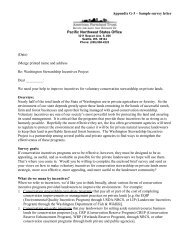


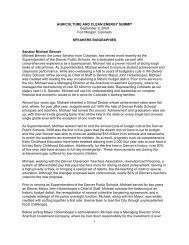
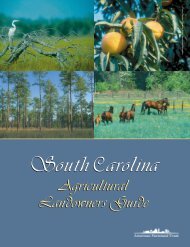
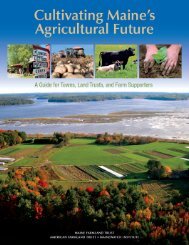
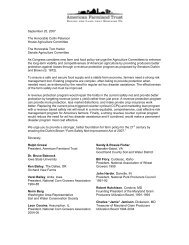
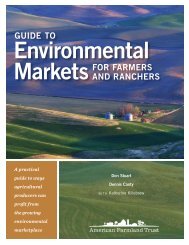
![Farmland by the Numbers [PDF] - American Farmland Trust](https://img.yumpu.com/31549391/1/190x245/farmland-by-the-numbers-pdf-american-farmland-trust.jpg?quality=85)
